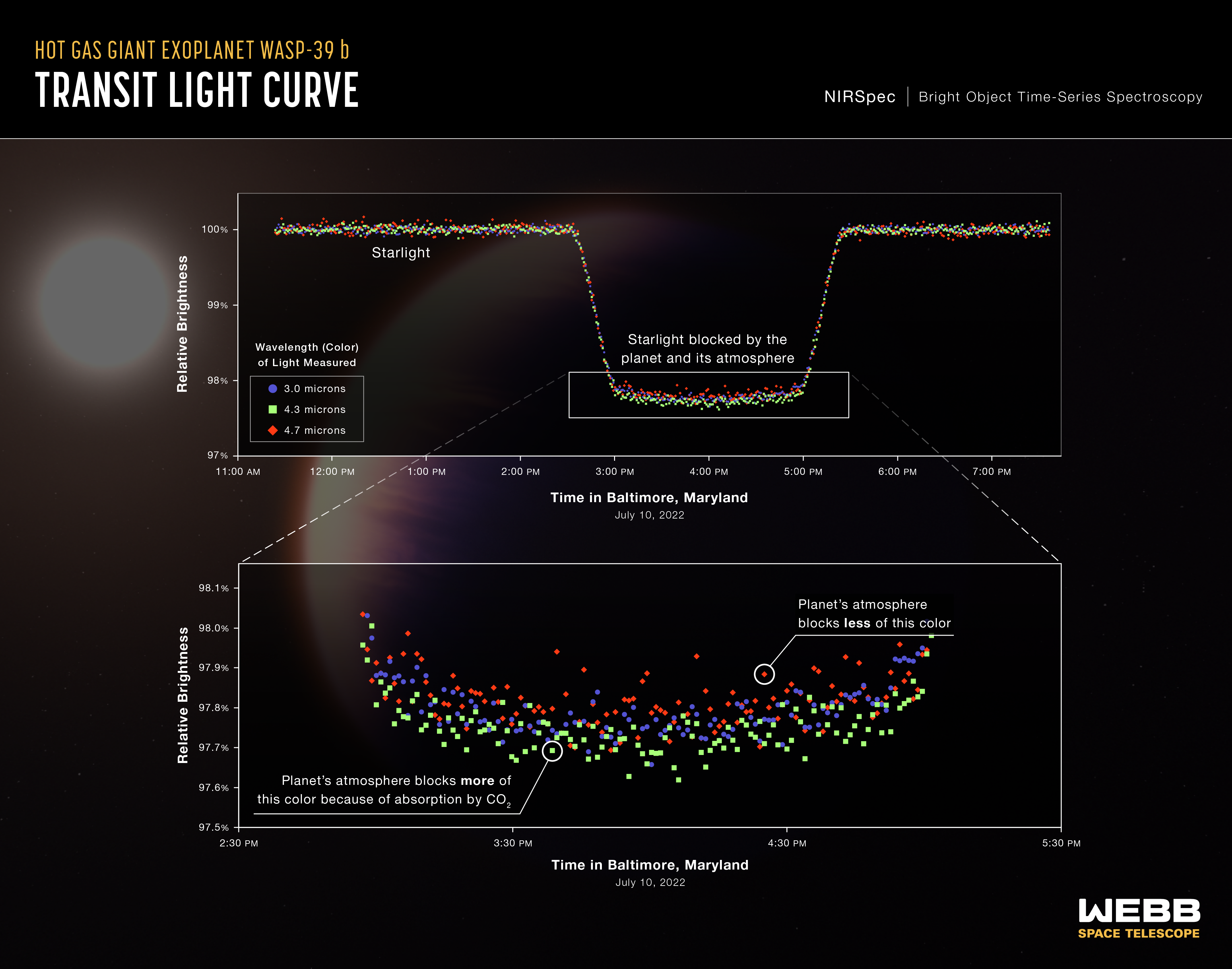1 min read
Exoplanet WASP-39 b (NIRSpec Transmission Spectrum)

A transmission spectrum of the hot gas giant exoplanet WASP-39 b captured by Webb’s Near-Infrared Spectrograph (NIRSpec) on July 10, 2022, reveals the first clear evidence for carbon dioxide in a planet outside the solar system. This is also the first detailed exoplanet transmission spectrum ever captured that covers wavelengths between 3 and 5.5 microns.
A transmission spectrum is made by comparing starlight filtered through a planet’s atmosphere as it moves in front of the star, to the unfiltered starlight detected when the planet is beside the star. Each of the 95 data points (white circles) on this graph represents the amount of a specific wavelength of light that is blocked by the planet and absorbed by its atmosphere. Wavelengths that are preferentially absorbed by the atmosphere appear as peaks in the transmission spectrum. The peak centered around 4.3 microns represents the light absorbed by carbon dioxide.
The gray lines extending above and below each data point are error bars that show the uncertainty of each measurement, or the reasonable range of actual possible values. For a single observation, the error on these measurements is extremely small.
The blue line is a best-fit model that takes into account the data, the known properties of WASP-39 b and its star (e.g., size, mass, temperature), and assumed characteristics of the atmosphere. Researchers can vary the parameters in the model – changing unknown characteristics like cloud height in the atmosphere and abundances of various gases – to get a better fit and further understand what the atmosphere is really like. The model shown here assumes that the planet is made primarily of hydrogen and helium, with small amounts of water and carbon dioxide, and a thin veil of clouds.
The observation was made using the NIRSpec PRISM bright object time-series mode, which involves using a prism to spread out light from a single bright object (like the star WASP-39) and measuring the brightness of each wavelength at set intervals of time.
WASP-39 b is a hot gas giant exoplanet that orbits a Sun-like star roughly 700 light-years away, in the constellation Virgo. The planet orbits extremely close to its star (less than 1/20th the distance between Earth and the Sun) and completes one orbit in just over 4 Earth-days. The planet’s discovery, based on ground-based observations, was announced in 2011. The star, WASP-39, is roughly the same size, mass, temperature, and color as the Sun.
The background illustration of WASP-39 b and its star is based on current understanding of the planet from Webb spectroscopy and previous ground- and space-based observations. Webb has not captured a direct image of the planet or its atmosphere.
About the Object
- R.A. PositionR.A. PositionRight ascension – analogous to longitude – is one component of an object's position.14:29:18.42
- Dec. PositionDec. PositionDeclination – analogous to latitude – is one component of an object's position.+03:26:40.2
- ConstellationConstellationOne of 88 recognized regions of the celestial sphere in which the object appears.Virgo
- DistanceDistanceThe physical distance from Earth to the astronomical object. Distances within our solar system are usually measured in Astronomical Units (AU). Distances between stars are usually measured in light-years. Interstellar distances can also be measured in parsecs.700 light-years
About the Data
- Data DescriptionData DescriptionProposal: A description of the observations, their scientific justification, and the links to the data available in the science archive.
Science Team: The astronomers who planned the observations and analyzed the data. "PI" refers to the Principal Investigator.This spectrum was created with data from Webb proposal 1366.
- InstrumentInstrumentThe science instrument used to produce the data.Near-Infrared Spectrograph (NIRSpec) PRISM, bright object time-series mode
- Exposure DatesExposure DatesThe date(s) that the telescope made its observations and the total exposure time.July 10, 2022
- Object NameObject NameA name or catalog number that astronomers use to identify an astronomical object.WASP-39 b
- Object DescriptionObject DescriptionThe type of astronomical object.Hot gas giant exoplanet
- Release DateAugust 25, 2022
- Science ReleaseNASA’s Webb Detects Carbon Dioxide in Exoplanet Atmosphere
- CreditIllustration: NASA, ESA, CSA, Leah Hustak (STScI), Joseph Olmsted (STScI)
Related Images & Videos

Exoplanet WASP-39 b and Its Star (Illustration)
This illustration shows what exoplanet WASP-39 b could look like, based on current understanding of the planet. WASP-39 b is a hot, puffy gas giant with a mass 0.28 times Jupiter (0.94 times Saturn) and a diameter 1.3 times greater than Jupiter, orbiting just 0.0486 astronomical...

Exoplanet WASP-39 b (NIRSpec Transit Light Curves)
A series of light curves from Webb’s Near-Infrared Spectrograph (NIRSpec) shows the change in brightness of three different wavelengths (colors) of light from the WASP-39 star system over time as the planet transited the star on July 10, 2022. A transit occurs when an orbiting...
Share
Details
Laura Betz
NASA’s Goddard Space Flight Center
Greenbelt, Maryland
laura.e.betz@nasa.gov
NASA, ESA, CSA, Leah Hustak (STScI), Joseph Olmsted (STScI)































